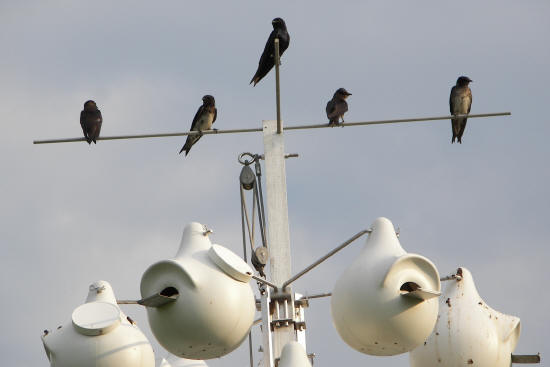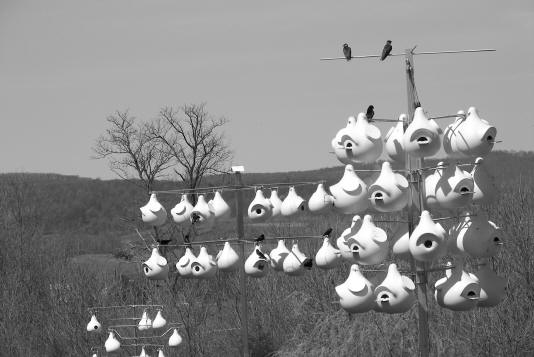Pets Large & Small
So you want to be a Purple Martin Landlord?
Rusty Ryan
Conservation Chairperson of the South Mountain Chapter
of the National Audubon Society
(March, 2010) Did you know that martins in eastern North America nest exclusively in bird houses (human supplied housing) or that one million households in North America provide housing for martins?
Over the past 10 years, numerous persons have asked me about "my colony" of martins. Some of these folks have been trying to establish their own colony but with little success.

It is hoped that this article will provide useful information as to what I've done or learned to be a lucky and so far successful landlord to these unique feathered tenants.
General information: The Purple Martin is the country's largest member of the swallow family. Martins are about the size of a Red -Winged Blackbird. Only the adult male sports the purple/black plumage. The martin can be found throughout the eastern half of the U.S. Martins feed primarily on flying insects.
The martin is a neo-tropical migrant. This means they breed in North America but migrate to warmer climates for the non-breeding season. Martins winter mostly in the country of Brazil. This annual migration ends up being about a 10,000 mile round-trip flight. Not bad for a bird that weighs a mere 2 ounces.
The first martins (scouts) generally arrive at my property about the third week of March. They are my harbinger of spring. The birds of my colony usually have left me by mid-August.
The establishment of my colony
My wife and I built our home on our Fairfield property back in 1997. The first several years I tried to attract breeding martins but with no success. I used an aluminum-housing complex, which I thought was erected in the correct location on the property. I had martins visit but no successful nesting.
A local martin landlord (see mentoring program on web site) gave me some advice about placement. It was his opinion that my housing was too near my non-manicured lawn. I extended my mowing but still no luck.
The next season I purchased some plastic decoys and a cd. The cd consists of recordings of martins performing certain vocalizations. These vocalizations are basically those of happy martins letting other martins know that my place is good to raise young. I fastened the decoys and proceeded to play the CD an hour before dawn. My wife thought I was crazy
but after a few days, I noticed martins. Since than, I've had an established colony. As a footnote, for the past several seasons, my youngest daughter and I have had a friendly competition as to who is the first to locate the first martin.
Some simplified tips for attracting "America's Most Wanted Bird"
I often joke that I practically provide everything for the martin except genetics.
Location, Location, Location!
When it comes to attracting martins, it's all about location. If you ever watch martins, you will quickly understand their aerial space requirements. Martins require open space for flight in and out of nesting area. Martins need to be in close proximity (30'-120') to occupied human housing. Martins are people birds. To establish a new colony, the
housing should also be a good 50' from trees and the areas surrounding the pole should be more or less clear of obstacles such as landscaping. Your odds are made even better by being near open water and/or near an established colony.
Housing/nesting
There are basically three types of housing: Gourds, (natural or plastic), aluminum boxes or wood boxes. My choice is exclusively gourds. About 2/3 are plastic and 1/3 are natural. Trivia: Prior to the arrival of Europeans, our Native Americans were hanging empty gourds for the martins. The height of the housing should be between 12'-20'. The housing
should also be manageable which means the pole should be telescoping so that the housing can be lowered for easy access to nests. All housing should be light in color.

Supplemental stuff
Food - There are times when a landlord may need to provide food because of a cold spell. There are several ways to provide the food. I've chosen to erect a separate feeding station with several shallow plates. Martins will readily eat crickets, mealworms and even scrambled eggs. I also provide crushed oyster shells, which they need for calcium and
grit.
I also line each gourd with some fine grasses or pine needles. This action provides comfort during that dreaded cold spell when flying insects are grounded.
Predators
The worse thing that could happen to a landlord and their colony is predation! A bad experience is enough to have that colony never return. A good landlord must monitor the colony and take immediate action. Obviously being proactive is better than being reactive. The most common predators are House Sparrows, Starlings, Black Rat snakes and Owls/Hawks.
I have twice experienced Black Rat snakes at my colony. I still don't know how they got up the metal poles but they did. Last year I applied Vaseline on the bottom 3 foot of pole and that seemed to work.
Tape and Decoy
If you have the right habitat and still no success do what many others and I have done and utilize the playing of the "dawnsong" recordings and use decoys.
Why Martins? Because they need humans and we need them if only for the pleasure and stress relief they provide. They are fun to listen to and even more fun to watch their aerial display and going about the job of raising their young. Not many wild birds can provide humans with such close-up activity.
So if you have the right property and you wish to become a martin landlord, check out the web sites and move forward with the tons of advice given. You still have time!
As per my last trip to the Purple Martin Society web site, the scouts have arrived in each of the states bordering the gulf coast. The scouts should arrive in this area around Easter. The sub-adults that the new landlord is hoping to attract usually arrive 4-6 weeks later.
Believe me when I say you won't regret being a landlord once you've been successful in establishing your own colony.
I hope you've learned some basics about Purple Martins. In my next article, I hope to provide guidance on attracting the Eastern Bluebird.
While not all property owners have the appropriate habitat requirements to successfully establish a colony, it you're looking to give it a try, here are some helpful websites that you can go to for more information: